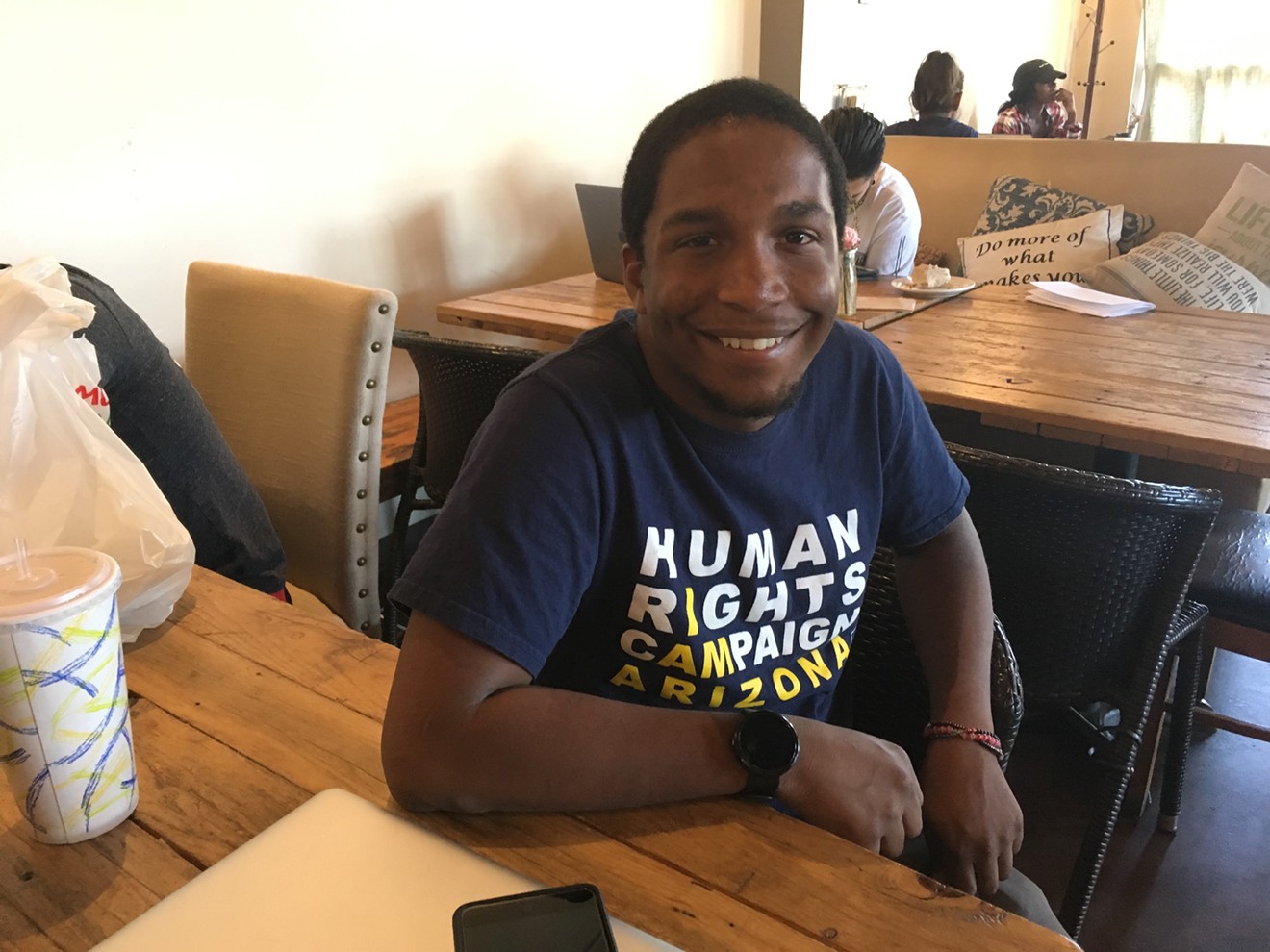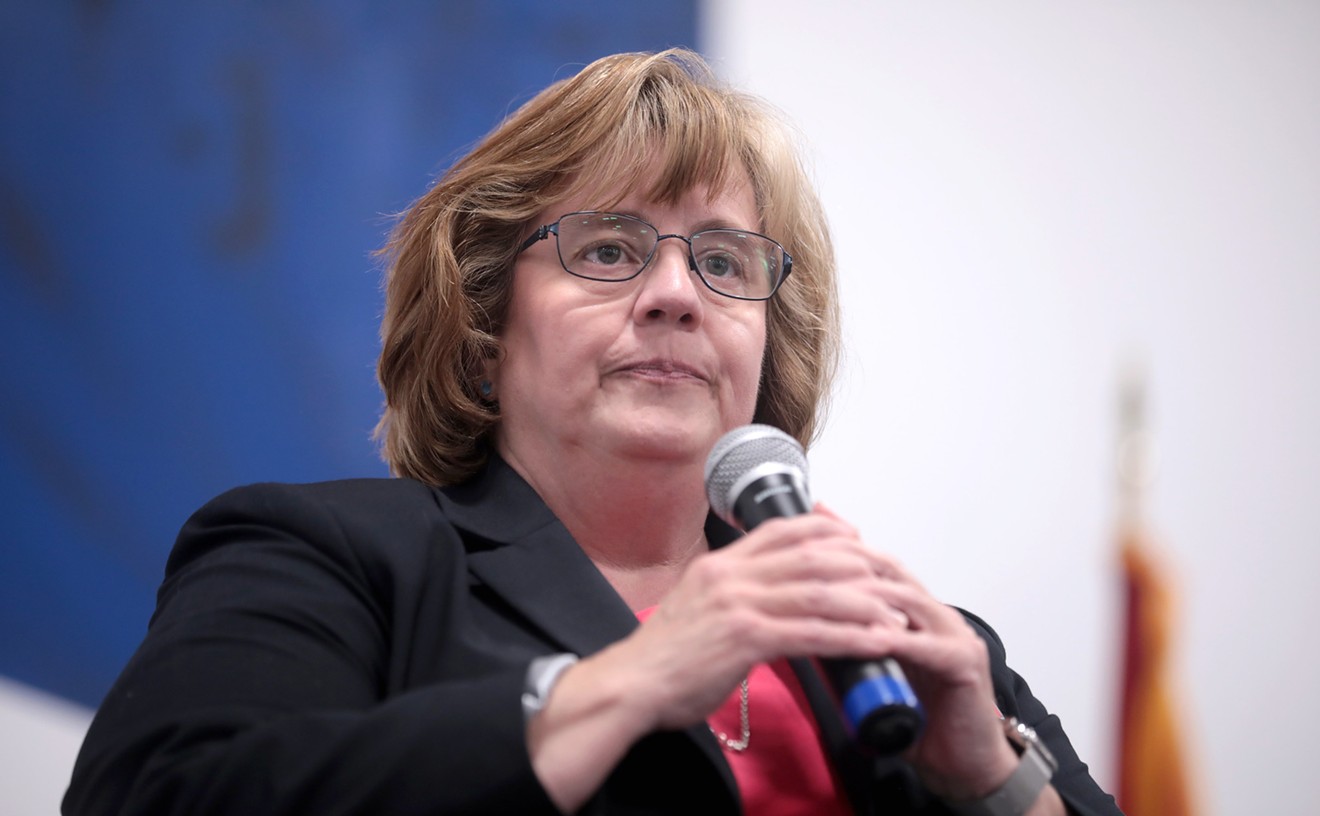The 22-year-old’s broad beam often garners instant rapport, even from strangers. There’s a trusty quality about it. Jones smiles often, even when talking about the grimmest of subjects.
Jones smiles, even while describing what it was like to be homeless.
The Detroit native came to Phoenix to live with an aunt while completing high school
“It just all didn’t work out,” Jones said. “I found myself kind of stranded.”"There have been a lot of priorities and problems in human services and, at this point, we have not been able to replace all that funding." — Linda Elliot
tweet this
Jones, who prefers they/them pronouns, couch surfed and stayed with friends until the welcomes ran out or Jones felt like an imposition. Jones' mother died when Jones was a toddler and their father was never around. Jones' aunt moved to California, and soon Jones felt the streets were the only option left.
Jones avoided homeless shelters such as CASS and St. Vincent de Paul out of fear.
“I’d heard stories about violence and drug use, and it’s just a harsh environment,” Jones said.
During the day, Jones would hang out at the Fair Trade Café, a funky coffee shop downtown with fluffy “Dream Big” pillows. They’d listen to
At night, they would settle in on a park bench or go to a bus stop. If Jones was sleep-deprived, they’d find a public restroom, sometimes at Fair Trade, and lock the door and nap until an impatient patron pounded on the door.
“The hardest part was not having a place of comfort and not being able to relax,” Jones said. “It’s one thing just not having sleep, but it’s another thing to not have somewhere where you can say, ‘I’m going to be here tonight and I know I’ll be okay’”
When family members asked questions, Jones would use an iPod to snap a picture, flash that bright beam, and reassure them everything was okay, that Jones was staying with friends.
But underneath the smile, everything wasn’t okay.
Jones is not alone.
This year’s Voices of Youth Count report from the University of Chicago’s Chapin Hall policy research center found that one in 10 young adults in America, ages 18 to 25, experienced some form of homelessness over the course of a year.
That’s 3.5 million young adults. About half of that group were what’s considered “explicitly” homeless — this includes running away or being kicked out — while the other half were involved in couch surfing.
The survey also found that some subpopulations were most vulnerable to homelessness. These populations included black, Hispanic, and LGBTQ youth, as well as people who didn’t complete high school and young parents.
Here in Maricopa County, the numbers aren’t as shocking on the surface. A Maricopa Association of Governments Point in Time Homeless Count Analysis from August 2017 found that there
Stephanie Smelnick, the Arizona field office director for the U.S. Department of Housing and Urban Development (HUD), said the numbers might be considerably higher than reported.
“The youth are the hardest to count,” Smelnick said. “Youth generally don’t self-identify as being homeless. If they have a couch to sleep on, they consider themselves housed.
"The other thing, when we’re out doing these point-in-time counts, it’s usually 5 o’clock in the morning, and we’re going to additional places looking for people on the street. You generally will not find the youth on the street. They’ll be couch-surfing or someplace else.”
Whatever the population of homeless youth, advocates say there are drastically more homeless young people than youth-specific housing options.
Linda Elliott has seen the need for youth-specific housing first-hand.
She’s been the executive director of one-n-ten, a local nonprofit that serves LGBTQ youth, for over six years. She knows that for every young adult her team gets off the streets, more need help.
One-n-ten houses homeless youth between the ages of 18 and 25 through their POND program — an acronym for Promise of a New Day.

Linda Elliott, the executive director at one-n-ten, says there aren't enough resources for youth who are homeless.
Courtesy of one-n-ten
Right now, one-n-ten is housing 18 teens, but Elliott said the group knows of about 50 youth seeking its housing resources.
Homeless youth housing programs like POND get their funding through a variety of sources. One-n-ten has a contract with the city of Phoenix, which gets funding from HUD, Elliot said. It has 15 housing vouchers from the city, but that contract ends next June.
The program gives youth a room to stay in while they work with case managers to develop skills they can use to live independently. According to program literature from 2015, they providing the supportive housing program for $10,000 per youth per year for up to 2 years.
In 2015, one-n-ten received a grant from the Parsons Foundation to help support 15 youth for two years, Elliot says. But that grant ended in September and has not been renewed.
“We’re constantly trying to refill the bucket,” Elliott said. “There have been a lot of priorities and problems in human services and, at this point, we have not been able to replace all that funding.”
Elliott says intervention from organizations that know how to work with homeless youth is imperative for a variety of reasons — perhaps the most important being safety.
Many advocates and groups like Shout Out Trafficking, a partnership between UNICEF and National Consortium for Academics and Sports, will hit you with the glaring statistic that one in three young people will be solicited for sex within 48 hours of being on the streets in America.
“Our youth, they’re resourceful and problem solvers,” Elliott said. “They think, ‘I need a place to sleep, I need food, that’s a way to get it.’ … We call it survival sex.”
But the problems don’t stop there, Elliott says. She notes trafficking can go hand-in-hand with drugs, which can lead to a downward spiral from which escape is difficult.
That’s why these youth often need targeted assistance to get them back on their feet.
Phoenix has three main organizations that offer homeless youth-specific housing: one-n-ten, UMOM New Day Centers, and Native American Connections.
Beyond offering transitional housing, these programs offer help with college readiness and courses that teach life skills and financial literacy.
Right now, UMOM and one-n-ten are the only two currently housing youth.
Dede Devine, the CEO of Native American Connections, said her organization lost its HUD funding through the Arizona Continuum of Care. Although previously the nonprofit offered youth transitional housing, that program has been on hold since July. Before their temporary shutdown, they served 18-24-year-olds of all ethnicities and races in a 25-bed environment.
Native American Connections is scheduled to reopen a renovated facility on January 7, which will focus on more emergency housing for youth. By December 2019, Devine hopes to have 24 studio apartments available for extended-stay youth housing.
They’re patching together funding for this from a variety of places — from Maricopa County to local foundations. The Arizona Department of Housing funded the facility renovations, Devine said.
Until last year, another organization called Tumbleweed Center for Youth Development provided resources and housing for homeless young people, but it went bankrupt in December 2016.
Since then, the three existing organizations focused on homeless youth have been working together to pick up the slack, Devine said.
But they can’t fill all the gaps without the resources to do it.
“I want to emphasize, that for all reasons — social, economic, human reasons — we need to invest in homeless youth,” Devine said. “If you help them get back into society and begin working and contributing, they can do so much. I want people to think of this as an investment.”
Chela Schuster, UMOM’s senior director of housing, emphasized that younger people on the streets have special needs that need to be addressed to prevent them from becoming chronically homeless.
“I think that there are definitely things specific to that population that we have to be aware of,” Schuster said. “A lot have grown up in foster-care systems and have limited vocational skills. A lot have never rented an apartment, don’t know the basics of tenancy, don’t know how to use a washing machine or dishwasher, don’t have an education yet, and need to have some extra help.”
That’s why Schuster says UMOM does everything possible to tailor services to fit the needs of youth who have such limited life experience.
That said,
“There are just limited amounts of housing and services for that population and so I think that is one of the problems,” Schuster said. “There just aren’t enough resources.”
On a larger scale, the future of funding and resources for youth experiencing homelessness — and those experiencing homelessness in general — lies primarily in the hands of Congress and its budget plans, according to HUD regional public affairs officer Ed Cabrera.
“Youth homelessness is one of a number of subpopulations that is a federal priority,” Cabrera said. “That being said, there are still a lot of question marks, given the uncertain budgetary environment that we’re in, about what funding we will have available to invest in the subpopulation.”
When Jones was living on the streets, Jones would eat breakfast and lunch at Native American Connections.
Finding dinner became more of a challenge.
Sometimes Jones would just wait it out until morning. Other times they would carefully approach people who looked nice, smile and, ask: “Hey, do you have any extra? If you don’t, it’s fine.”
After about three weeks of this, Jones' luck started to turn.
While asking for food one night, Jones says a man who worked at Segal's Oasis Grill & Kosher Foods said, “No, but do you want a job?”
Jones took him up on the offer and soon was able to afford a hotel room to stay in.
Around the same time, a friend brought Jones to one-n-ten. Not out as bisexual yet, Jones was a little timid to join the program and even more anxious about asking about housing options.
Finally, Jones approached someone about getting into POND. Jones says they got into the program over about a three-week period.
Having a place to crash land was a relief. Jones decorated the room POND provided, hanging Christmas lights on the walls and placing their graduation cap on a nail above the bed. Jones proudly hung their high school diploma as a centerpiece on one of the white walls.
“I liked to call it my nest,” Jones recalls. “I’d put my head down and relax and be comfortable there.”
Jones says POND was a place that allowed them to find themselves.
"I got into POND and I could be comfortable,” Jones said. “You have to be comfortable where you’re at … When I was in POND, I was surrounded by friends. I could go talk to them like, ‘Hey, how does this makeup look on me?’”
Sitting at a table at Fair Trade Café last month, Jones reflected on how far they've come since living on the streets and napping in the cafe's bathroom about four years ago.
With the help of one-n-ten, Jones has landed a gig as a youth ambassador for the Human Rights Campaign Arizona, an LGBTQ advocacy organization. Jones is out of the POND program, living with a roommate in a house in Central Phoenix. At the end of October, the Human Rights Campaign sent Jones to Washington, D.C., for their national dinner, where Hillary Clinton and California U.S. Senator Kamala Harris spoke.
“I’m a living example of what can happen if you find something like one-n-ten that can help you be all that you can be,” Jones said.
Then, Jones smiled.











